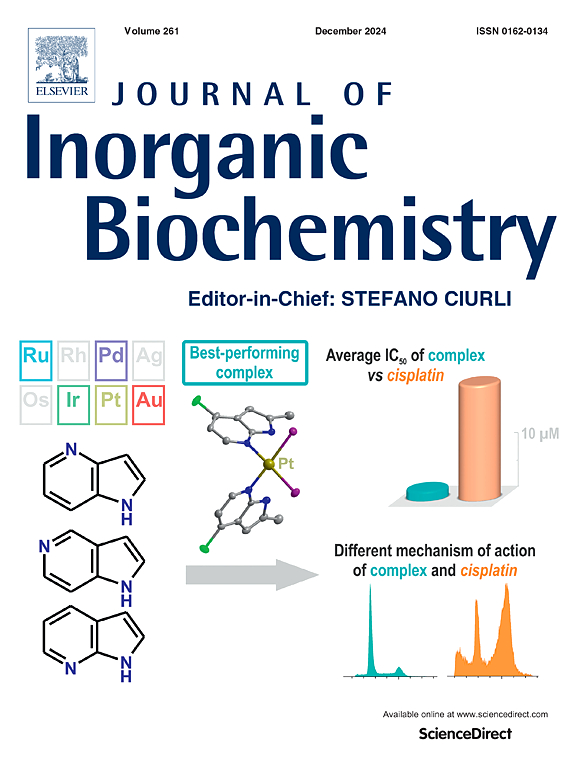Silver(I) complexes containing bioactive salicylic acid derivatives: Synthesis, characterization, antibacterial activity, and their underlying mechanism
IF 3.8
2区 化学
Q2 BIOCHEMISTRY & MOLECULAR BIOLOGY
引用次数: 0
Abstract
Recognizing that silver-metallodrugs are a potential source of novel anti-infective therapeutic agents, this work adopts the complexation of biologically active salicylic acid derivatives with inherently antibacterial silver(I) ions as a strategy for developing new antibacterial agents. The synthesized silver(I) complexes were characterized by elemental analysis, spectroscopy, and X-ray diffraction analysis. The crystallographic results indicate that the silver(I) ion in complexes [Ag(imH)2](SalH) (1) and [Ag(imH)2](DiSalH)·H2O (2) only coordinates with the imidazole nitrogen atom, while the 4-aminosalicylic acid in complex [Ag(imH)2(AmSalH)]·H2O (3) additionally coordinate with the silver(I) ion through the amino nitrogen atom. Salicylic acid molecules play an important role in the construction of the three-dimensional network structure through weak interactions. In addition, thermogravimetric analysis, stability, and silver(I) ion release experiments indicate that these complexes have good stability and slow ion release rates. Cell toxicity and antibacterial tests were conducted on selected cell lines and microorganisms using complexes 1–3, and compared with silver(I) salts, organic ligands, and antibiotic. All complexes exhibit better biocompatibility and certain anti-tumor selectivity than silver(I) salts. From the perspective of microbial toxicity, complexes 1–3 all have significant inhibitory effects on three bacteria strains, with complex 1 having the strongest antibacterial activity, exhibiting 4–6 times higher activity against certain strains than AgNO3 and chloramphenicol. Mechanism studies have shown that cell wall perforation and imbalance of intracellular ROS levels may be possible reasons for silver(I) complexes induced bacterial cell death. The biofilm removal experiment further proves the potential use of silver(I) complexes 1–3 in the treatment of bacterial infections.

含生物活性水杨酸衍生物的银(I)配合物:合成、表征、抗菌活性及其潜在机制
认识到银金属药物是新型抗感染治疗剂的潜在来源,本工作采用生物活性水杨酸衍生物与固有抗菌银(I)离子的络合作为开发新型抗菌药物的策略。通过元素分析、光谱分析和x射线衍射分析对合成的银(I)配合物进行了表征。晶体学结果表明,配合物[Ag(imH)2](SalH)(1)和[Ag(imH)2](DiSalH)·H2O(2)中的银(I)离子仅与咪唑氮原子配位,而配合物[Ag(imH)2(AmSalH)]·H2O(3)中的4-氨基水杨酸还通过氨基氮原子与银(I)离子配位。水杨酸分子通过弱相互作用在三维网络结构的构建中起着重要作用。此外,热重分析、稳定性和银离子释放实验表明,这些配合物具有良好的稳定性和缓慢的离子释放速率。使用配合物1-3对选定的细胞系和微生物进行了细胞毒性和抗菌试验,并与银(I)盐、有机配体和抗生素进行了比较。所有配合物均表现出较银(I)盐更好的生物相容性和一定的抗肿瘤选择性。从微生物毒性角度看,配合物1 ~ 3对3种菌株均有明显的抑制作用,其中配合物1的抑菌活性最强,对某些菌株的抑菌活性比AgNO3和氯霉素高4 ~ 6倍。机制研究表明,细胞壁穿孔和细胞内ROS水平失衡可能是银(I)复合物诱导细菌细胞死亡的可能原因。生物膜去除实验进一步证明了银(I)配合物1-3在治疗细菌感染中的潜在应用。
本文章由计算机程序翻译,如有差异,请以英文原文为准。
求助全文
约1分钟内获得全文
求助全文
来源期刊

Journal of Inorganic Biochemistry
生物-生化与分子生物学
CiteScore
7.00
自引率
10.30%
发文量
336
审稿时长
41 days
期刊介绍:
The Journal of Inorganic Biochemistry is an established international forum for research in all aspects of Biological Inorganic Chemistry. Original papers of a high scientific level are published in the form of Articles (full length papers), Short Communications, Focused Reviews and Bioinorganic Methods. Topics include: the chemistry, structure and function of metalloenzymes; the interaction of inorganic ions and molecules with proteins and nucleic acids; the synthesis and properties of coordination complexes of biological interest including both structural and functional model systems; the function of metal- containing systems in the regulation of gene expression; the role of metals in medicine; the application of spectroscopic methods to determine the structure of metallobiomolecules; the preparation and characterization of metal-based biomaterials; and related systems. The emphasis of the Journal is on the structure and mechanism of action of metallobiomolecules.
 求助内容:
求助内容: 应助结果提醒方式:
应助结果提醒方式:


